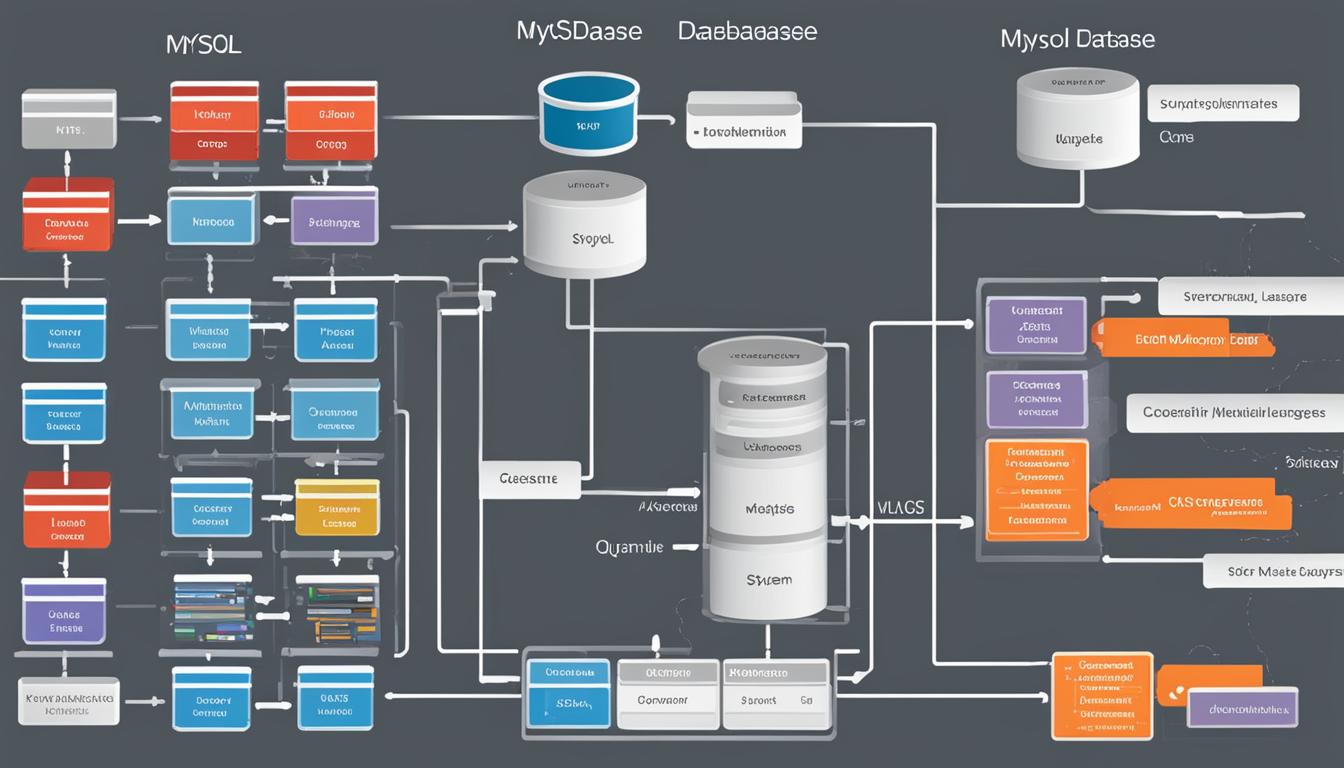Understanding What is MySQL: Database Essentials
MySQL is a relational database management system (RDBMS) developed by Oracle based on structured query language (SQL). It is one of the most recognizable technologies in the modern big data ecosystem and is widely used in various industries. MySQL allows users to build fast, powerful, and secure data storage systems, making it an essential tool for anyone involved with enterprise data or IT.
In this article, I will provide you with an overview of MySQL, its features, and its importance in database management. Whether you are a beginner or already familiar with databases, this guide will help you understand the basics of MySQL and its practical applications in the real world.
Key Takeaways:
- MySQL is a widely used relational database management system.
- It is based on structured query language (SQL) and is developed by Oracle.
- MySQL enables users to create secure and powerful data storage systems.
- It is essential for enterprise data management and IT professionals.
- Understanding MySQL is crucial in today’s data-driven world.
What is MySQL?
MySQL is a relational database management system (RDBMS) that is based on structured query language (SQL). It is used to store and manage large amounts of structured data in a logical and organized manner.
MySQL is integral to many popular software stacks and is employed by internet-critical organizations such as Facebook, Twitter, and YouTube. It is known for its stability, rich feature set, and wide compatibility with different platforms and programming interfaces.
With MySQL, users can benefit from its powerful data management capabilities and leverage its robust query optimization techniques. Its reliability and scalability make it a popular choice for companies of all sizes.
“MySQL is a valuable tool for anyone looking to efficiently organize and access their data. Its intuitive interface and extensive documentation make it accessible to beginners while also catering to the needs of experienced users.”
MySQL’s extensive features and functionalities allow users to perform a wide range of tasks, from simple data retrieval and manipulation to complex database administration. It supports transactions, triggers, stored procedures, and more.
Furthermore, MySQL’s compatibility with various programming languages and platforms makes it a versatile and flexible database solution for developers. Whether you are building a web application or a data-intensive enterprise system, MySQL can meet your requirements.
Key Features of MySQL
| Feature | Description |
|---|---|
| Data Security | MySQL provides robust security features such as encryption, user authentication, and role-based access control to ensure data confidentiality and integrity. |
| High Performance | MySQL is designed for high-speed data processing, with efficient query execution and optimization techniques. |
| Scalability | MySQL can handle large datasets and supports horizontal scaling, allowing you to scale your database infrastructure as your business grows. |
| Replication | MySQL supports replication, enabling data redundancy and creating backups for disaster recovery purposes. |
| Flexibility | MySQL can be customized and extended through various plugins and extensions, supporting a wide range of use cases. |
In conclusion, MySQL is a powerful and versatile RDBMS that provides users with an efficient and reliable solution for managing their data. Its extensive features, compatibility, and scalability make it the ideal choice for various applications and industries.
4 Keys to Understanding MySQL
To truly comprehend the power and versatility of MySQL, it’s essential to grasp its key characteristics. MySQL is not only compatible with various technologies and architectures but also runs seamlessly on all major computing platforms. This wide compatibility ensures that users can harness its potential regardless of their preferred technology stack.
Moreover, MySQL offers support for different programming interfaces, making it easier for developers to integrate and interact with the database. Whether you’re working with Python, PHP, or any other programming language, MySQL provides the flexibility and tools you need for seamless integration.
One of the fundamental features of MySQL is its relational database structure. This means that data is organized into separate tables, allowing for efficient management and retrieval of information. The logical structure of MySQL ensures that data remains consistent and that relationships between different entities can be easily established.
As an open-source platform, MySQL provides users with limitless possibilities for customization and extensibility. Whether you want to modify existing functionality or build new features from scratch, MySQL allows you to tailor the database according to your unique requirements.
Last but not least, MySQL is renowned for its user-friendly features and ease of use. Even beginners can quickly grasp its concepts and start using it effectively. Its intuitive interface, extensive documentation, and active community support contribute to MySQL’s reputation as one of the most user-friendly database management systems available.
Overall, understanding these four key aspects—compatibility, programming interfaces, relational structure, and user-friendliness—is crucial to harnessing the full potential of MySQL and leveraging its capabilities for your projects.
MySQL Databases and the Power of Relational Data Organization
In the world of data management, MySQL databases offer a powerful solution for storing and organizing data. One of the key features that sets MySQL apart is its ability to handle relational databases, which play a crucial role in data organization and the establishment of logical models.
A relational database, such as MySQL, is designed to store information in separate tables. Each table represents a specific entity or concept, with rows representing individual records and columns representing different attributes or fields. This table-based approach allows for efficient data retrieval, updates, and complex actions.
Relational models provide users with intuitive, declarative programming languages that enhance data manipulation and analysis. By defining relationships between tables, MySQL enables users to establish logical connections and enforce consistency across the database. This ensures data integrity and enhances the reliability of the stored information.
Let’s take a closer look at an example to better understand the power and flexibility of relational databases. Suppose we have a bookstore database with two tables: “Books” and “Authors.” The “Books” table includes information about each book, such as its title, genre, and price. The “Authors” table, on the other hand, contains details about the authors, including their names and biographies.
By establishing a relationship between these tables, we can connect authors to their respective books. This linkage allows us to retrieve information in a structured and efficient manner. For instance, if we want to find all the books written by a particular author, we can simply query the database using the unique author ID.
This relational approach to data organization offers numerous benefits. It simplifies data retrieval and enables complex queries, such as filtering, sorting, and joining tables, to obtain specific information. Relational databases also provide a platform for data analysis, making it easier to generate insights and identify trends.
MySQL Database Example – Books and Authors
| Books | Authors |
|---|---|
| The Great Gatsby | F. Scott Fitzgerald |
| To Kill a Mockingbird | Harper Lee |
| 1984 | George Orwell |
| Pride and Prejudice | Jane Austen |
As shown in the example table above, the “Books” table lists the titles of popular books, while the “Authors” table includes the names of the authors. By linking the two tables, we can establish connections and retrieve specific information, such as finding the author of a particular book or the books written by a specific author.
MySQL’s ability to handle relational databases and support data organization according to logical models provides users with a flexible and user-friendly database system. Whether you’re a beginner or an experienced user, leveraging the power of MySQL’s relational capabilities can enhance your data management and analysis workflows.

Conclusion
MySQL is a powerful and widely used relational database management system that offers a range of features and benefits. Its wide compatibility with different platforms makes it a versatile choice for various applications, from customer-facing web applications to data-driven B2B services. With MySQL, developers can enjoy ease of use and high reliability, ensuring efficient data storage and management.
One of the key advantages of MySQL is its compatibility. It seamlessly integrates with different technologies and architectures, making it adaptable to diverse environments. This flexibility empowers developers to leverage MySQL in their preferred computing platforms and utilize a wide range of programming interfaces.
Furthermore, MySQL’s intuitive and user-friendly features have contributed to its popularity among beginners and experienced users alike. Its logical and organized structure enables easy data retrieval, updates, and complex actions. Additionally, as an open-source database, MySQL allows for customization and offers developers the freedom to tailor it to their specific requirements.
In today’s data-driven world, understanding MySQL is essential for anyone involved with enterprise data or IT. With its robust features, wide compatibility, and ease of use, MySQL continues to be a reliable choice for major companies and organizations worldwide. Embracing MySQL empowers businesses to build fast, powerful, and secure data storage systems that support their growth and success.
FAQ
What is MySQL?
MySQL is a relational database management system (RDBMS) based on structured query language (SQL). It is used to store and manage large amounts of structured data in a logical and organized manner.
What are the key characteristics of MySQL?
MySQL is widely compatible, runs on major computing platforms, and supports different programming interfaces. It follows a relational model, organizing data into separate tables, and is known for its ease of use and user-friendly features.
How do MySQL databases organize data?
MySQL databases use a relational model, storing data in separate tables and following a logical structure. This allows for optimized data retrieval, updates, and more complex actions.
Why is MySQL popular?
MySQL is a powerful and widely used database management system. It offers wide compatibility, ease of use, and high reliability. It is suitable for various applications and used by major companies and organizations worldwide.
- About the Author
- Latest Posts
Mark is a senior content editor at Text-Center.com and has more than 20 years of experience with linux and windows operating systems. He also writes for Biteno.com






